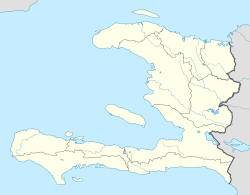San Miguel de la Atalaya
|
Saint-Michel-de-l'Attalaye Sen Michèl Latalay |
|
|---|---|
| Commune | |
| Location in Haiti | |
| Coordinates: 19°22′0″N 72°20′0″W / 19.36667°N 72.33333°WCoordinates: 19°22′0″N 72°20′0″W / 19.36667°N 72.33333°W | |
| Country |
|
| Department | Artibonite |
| Arrondissement | Dessalines |
| Founded in | 1768 |
| Founded by | José de Guzmán y Meléndez, Viscount of San Rafael de la Angostura |
| Elevation | 420 m (1,380 ft) |
| Population (7 August 2003) | |
| • Total | 95,216 |
Saint-Michel-de-l'Attalaye (Haitian Creole: Sen Michèl Latalay; Spanish: San Miguel de la Atalaya) is a commune in the Marmelade Arrondissement, in the Artibonite department of Haiti. It has 95,216 inhabitants. It is the second largest city geographically after Port-au-Prince, the national capital. Located in the Central Plateau, it is home to several large Christian churches including one which has been there for over 50 years. It is a scenic locale, surrounded by rich farmland, abundant water resources and distant mountain peaks in every direction. There are excellent schools which are privately funded and a current (2011) small residential development outside of the main town area which is near completion which was originally sponsored by the central government. There is a new joint venture nearing completion with a Taiwanese partner that plans to bring bamboo crafts and goods manufacturing skills training to the local people.
The area is the one of the least prone to earthquakes according to local government expertise. There is a new city hall nearing completion with excellent modern construction techniques and classic architecture (summer 2011).
Saint-Michel-de-l'Atalaye was founded in 1768 as San Miguel de la Atalaya, on the grounds of the Estancia Marigallega by lieutenant-colonel José de Guzmán y Meléndez (who was later created Baron of San Miguel de la Atalaya by Charles III of Spain) and was populated by settlers from the Canary Islands. In 1773, it was signed the Treaty of San Miguel de la Atalaya on this town, between the governors of Santo Domingo (Spanish colony) and Saint-Domingue (French colony), which became available to create two committees to develop a boundary between the two colonies with reference to the rivers Dajabón and Pedernales.
...
Wikipedia

